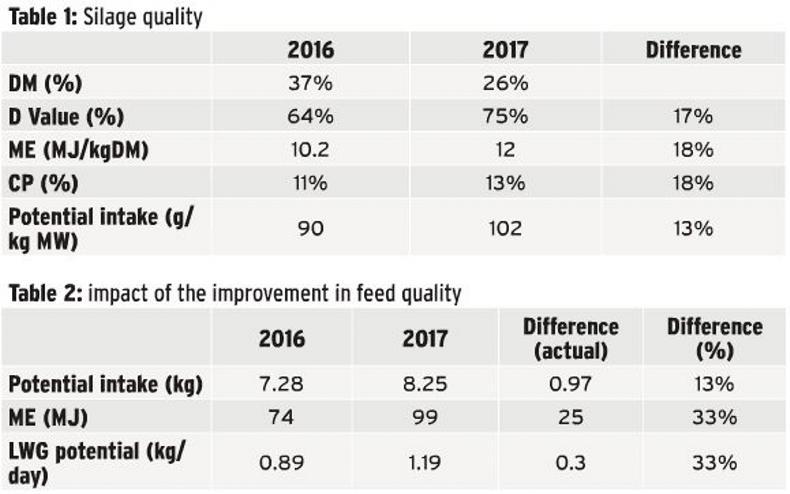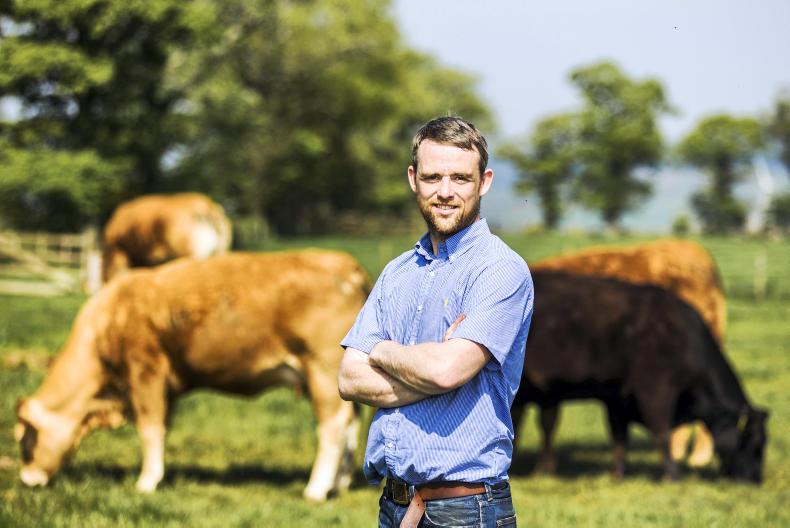In 2016, Andrew Gammie made one bulky cut of ag bag silage in late June. This was analysed and the cattle were rationed appropriately to take them through the winter. However, the feed value of the silage, with being made later in June was below average. The dry cows worked fine on this silage but the youngstock needed more and it took more concentrates than ideal to get them through the winter. This year, to get away from this issue, Andrew has changed two things:
The dry cow diet for most of winter is going to be ammonia straw, meaning that silage quality has no impact on their diet, allowing better quality silage to be made.First-cut grass silage was completed much earlier in the season, on the 22nd of May.Silage quality
This earlier silage has a far higher feed value and will be more useful to the youngstock this winter. Table 1 compares this year’s silage samples with last year’s. As can be seen, there is a significant improvement across digestibility, energy and protein of 17-18%.
These improvements have led to a 13% increase in the potential intake of the silage. Potential intake is a measurement, based on several parameters of how much of the silage an animal can eat, if fed ad-lib.

Impact of silage quality
Table 2 demonstrates the full impact of the improvement in feed quality. Liveweight gain is driven by the amount of energy an animal can utilise per day. Two factors drive this, the amount they can eat (Potential Intake) and the energy level (ME) of what they are eating.
To demonstrate the difference, table 2 below compares the effect the two silages at Drumforber would have on a 350kg growing animal eating ad-lib silage. The first thing to note is that the higher potential intake means that it will eat nearly 1kg a day more of the 2017 silage than it will of the 2016 silage. Secondly, when the higher energy value of the 2017 silage is taken in to consideration and multiplied by the potential intake level, it is consuming 33% more energy per day.
In this case, that would lead to a 0.3kg/day increase in growth rate. At £2.25/kg, that is worth 68 pence per day. It is eating more silage per day, however, that is only costing 10p per day, leading to a daily increase of 58 pence. Over a 150 day winter this is worth £88 per animal.
Read more
Weaning gets swiftly under way at Drumforber
In 2016, Andrew Gammie made one bulky cut of ag bag silage in late June. This was analysed and the cattle were rationed appropriately to take them through the winter. However, the feed value of the silage, with being made later in June was below average. The dry cows worked fine on this silage but the youngstock needed more and it took more concentrates than ideal to get them through the winter. This year, to get away from this issue, Andrew has changed two things:
The dry cow diet for most of winter is going to be ammonia straw, meaning that silage quality has no impact on their diet, allowing better quality silage to be made.First-cut grass silage was completed much earlier in the season, on the 22nd of May.Silage quality
This earlier silage has a far higher feed value and will be more useful to the youngstock this winter. Table 1 compares this year’s silage samples with last year’s. As can be seen, there is a significant improvement across digestibility, energy and protein of 17-18%.
These improvements have led to a 13% increase in the potential intake of the silage. Potential intake is a measurement, based on several parameters of how much of the silage an animal can eat, if fed ad-lib.

Impact of silage quality
Table 2 demonstrates the full impact of the improvement in feed quality. Liveweight gain is driven by the amount of energy an animal can utilise per day. Two factors drive this, the amount they can eat (Potential Intake) and the energy level (ME) of what they are eating.
To demonstrate the difference, table 2 below compares the effect the two silages at Drumforber would have on a 350kg growing animal eating ad-lib silage. The first thing to note is that the higher potential intake means that it will eat nearly 1kg a day more of the 2017 silage than it will of the 2016 silage. Secondly, when the higher energy value of the 2017 silage is taken in to consideration and multiplied by the potential intake level, it is consuming 33% more energy per day.
In this case, that would lead to a 0.3kg/day increase in growth rate. At £2.25/kg, that is worth 68 pence per day. It is eating more silage per day, however, that is only costing 10p per day, leading to a daily increase of 58 pence. Over a 150 day winter this is worth £88 per animal.
Read more
Weaning gets swiftly under way at Drumforber






SHARING OPTIONS